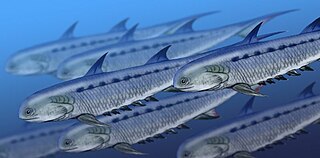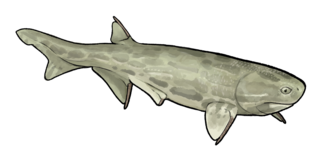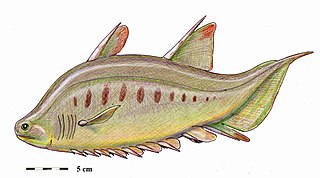
Chondrichthyes is a class of jawed fish that contains the cartilaginous fish or chondrichthyians, which all have skeletons primarily composed of cartilage. They can be contrasted with the Osteichthyes or bony fish, which have skeletons primarily composed of bone tissue. Chondrichthyes are aquatic vertebrates with paired fins, paired nares, placoid scales, conus arteriosus in the heart, and a lack of opecula and swim bladders. Within the infraphylum Gnathostomata, cartilaginous fishes are distinct from all other jawed vertebrates.

Acanthodii or acanthodians is an extinct class of gnathostomes. They are currently considered to represent a paraphyletic grade of various fish lineages basal to extant Chondrichthyes, which includes living sharks, rays, and chimaeras. Acanthodians possess a mosaic of features shared with both osteichthyans and chondrichthyans. In general body shape, they were similar to modern sharks, but their epidermis was covered with tiny rhomboid platelets like the scales of holosteians.

Climatius is an extinct genus of spiny shark. This genus is known from the Early Devonian (Lochkovian) of Europe, previously considered Silurian remains actually belong to Nostolepis instead.

Acanthodes is an extinct genus of acanthodian fish. Species have been found in Europe, North America, and Asia, spanning the Early Carboniferous to the Early Permian, making it one of the youngest known acanthodian genera.

Mesacanthus is an extinct genus of acanthodian fish from Devonian Scotland. It is among the more primitive of the Devonian acanthodians.

Cheiracanthus is an extinct genus of a group of fish called Acanthodii. It was a deep-bodied acanthodian about 12 in. (30 cm) in length. It had a blunt head, upturned tail, and fins protected by spines. Unlike many other acanthodians, it had one, solitary dorsal fin. Cheiracanthus swam at mid-depth in lakes and rivers, seizing small prey in its gaping jaws. Whole fossils of this fish occur only in Mid-Devonian rocks in Scotland, but its distinctive small, ornamented scales crop up around the world, as far south as Antarctica.

Parexus is an extinct genus of acanthodian fish. Acanthodians are often referred to as ‘spiny sharks’, although acanthodians are not true sharks and evolved perhaps 50 million years earlier than sharks. Acanthodians share several features with bony fish and cartilaginous fish; they often have spines supporting their fins.
Podoliacanthus is an extinct genus of Acanthodii which existed in what is now Greenland and Ukraine during the early Devonian period. It was described by Victor Voichyshyn and Hubert Szaniawski in 2012, and the type species is Podoliacanthus zychi. It also contains three presently undescribed species.

Brochoadmones is an extinct genus of acanthodian from the Devonian of what is now Canada. It is the only genus in the suborder Brochoadmonoidei, whose relationship to other acanthodian orders remains currently in flux.

Tetanopsyrus is a genus of Acanthodii. There are two species of this genus that lived through the lower Devonian (Lochkovian), some 416 to 359 million years ago.
The Escuminac Formation is a geologic formation in Quebec. It preserves fossils dating back to the Frasnian, in the Devonian period.

Gyracanthides is an extinct genus of acanthodian gnathostome, known from Devonian to Early Carboniferous.
This list of fossil fishes described in 2017 is a list of new taxa of jawless vertebrates, placoderms, acanthodians, fossil cartilaginous fishes, bony fishes and other fishes of every kind that are scheduled to be described during the year 2017, as well as other significant discoveries and events related to paleontology of fishes that are scheduled to occur in the year 2017. The list only includes taxa at the level of genus or species.

Ptomacanthus is an extinct genus of spiny shark, an early relative of living cartilaginous fishes.

Diplacanthiformes is an order of "acanthodian" stem-chondrichthyans which lived during the Devonian Period.

Websteroprion is a genus of eunicidan polychaete that lived during the middle Devonian period in what is now Canada. It contains a single species, W. armstrongi, recovered from the Kwataboahegan Formation.

Triazeugacanthus is an extinct genus of spiny shark from the Devonian of Canada. It contains a single species, Triazeugacanthus affinis. With total length up to 5.272 centimetres (2.076 in), it is known from multiple ontogenetic stages.
Xylacanthus is a genus of extinct acanthodian fish belonging to the family Ischnacanthidae. It lived during the Silurian to Devonian periods. Three species of Xylacanthus are known, X. kenstewarti from Late Wenlock to Early Ludlow from the Mackenzie Mountains in Canada, X. minutus from Lochkovian of Spitsbergen in Norway, and X. grandis from Siegenian of Spitsbergen. X. grandis was the largest acanthodian with 35 cm (14 in) long jaw bone and estimated total length of 2.5 m.
Acanthodopsis is a genus of Acanthodian fish from the family Acanthodidae. It lived during the Carboniferous period. Acanthodopsis fossils have been discovered in Australia and England. The largest species could have reached up to 75 cm in length while others were much smaller.















